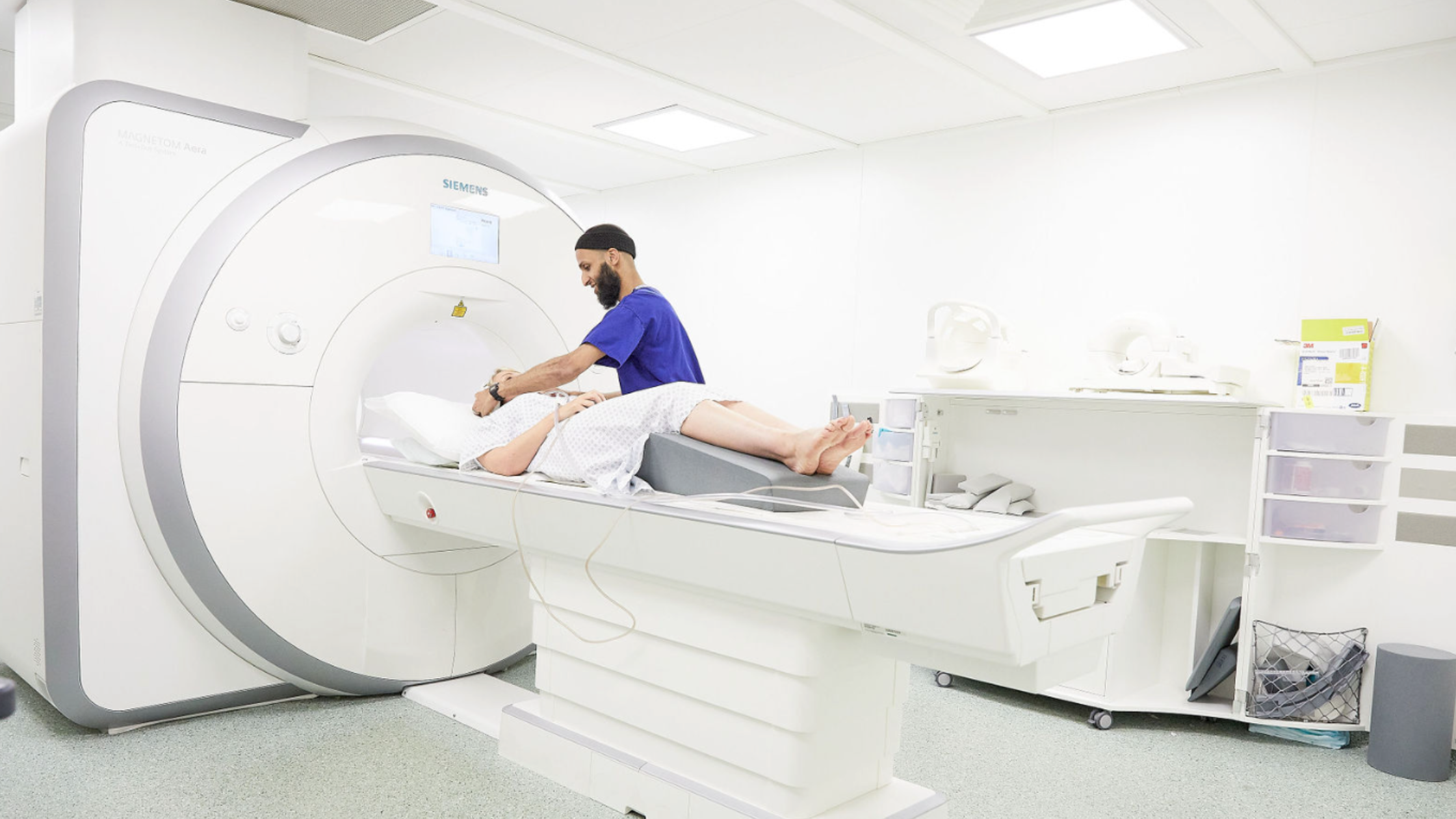1. What is a CT scan? /CAT (CT) Scan definition
A CT (Computerised Tomography) scanner is a special kind of X-ray machine.
A CT scan uses X-rays to take detailed images of parts of your body and the structures inside your body. During the scan, you will lie on a table that is attached to the CT scanner.
Depending on which you request, the scanner will take images of the relevant parts of your body.
2. What does a CT scan show?
The cross-sectional images generated during a CT scan can be reformatted in multiple planes, and can even generate three-dimensional images of your body. These images can be viewed on a computer monitor, printed on film or transferred to a CD or DVD. CT scanning is particularly useful for getting detailed 3D images of certain parts of the body, such as:
- Soft tissues
- Blood vessels
- Brain
Typically CT scans provide more detail for these areas than traditional X-rays.
3. What can a CT scan be used for?
The most commonly performed CT scan is of the brain, which can be used to determine the cause of a stroke or to assess serious head injuries. Other uses of aCT scans can be to:
- Detect abnormalities in the body, such as tumours, abscesses, abnormal blood vessels, etc, when they are suspected by symptoms or other tests.
- Give a surgeon a clear picture of an area of your body before certain types of surgery.
- Pinpoint the exact site of tumours prior to radiotherapy.
- Help doctors find the right place to take tissue samples (biopsies).
4. How does a CT scanner work?
A CT scanner emits a series of narrow X-ray beams through the human body as it moves through an arc, unlike an X-ray machine which sends just one radiation beam. The final set of images are far more detailed than an X-ray image.
Inside the CT scanner, there is an X-ray detector which can see hundreds of different levels of density, including tissues inside a solid organ. This data is transmitted to a computer, which builds up a 3D cross-sectional picture of the part of the body and displays it on the screen for the radiologist to report on.
5. What does a CT scanner look like?
Our Siemens Somatom Emotion is one of the highest quality CT scanners available in the country.
The CT scanner is typically a large, box-like machine with a hole or short tunnel, in the centre. Often called a polo mint. You will lie on a narrow examination table that slides into and out of this tunnel (shaped like a large doughnut). Rotating around you, the X-ray tube and electronic X-ray detectors are located opposite each other in a ring, called a gantry.
6. Are there any side effects from a CT scan?
Pall Mall Medical's CT scanner is extremely high quality. As such, it emits less radiation than other CT scanners.
One must weight the benefits of the images produced by the CT scan with the risk of radiation. The referring clinician and radiographer will advise on this during the referral stage. It may be that an MRI scan is more suitable.
In certain cases, your doctor may recommend you receive a special dye called a xe2x80x98contrast material' through a vein in your arm before the CT scan. Although rare, the contrast material can cause medical problems or allergic reactions. Most reactions are mild and result in a rash or itchiness.
The CT scan is a very safe procedure. Some people who have an injection of iodinated contrast material may feel nauseous for a short time afterwards. On rare occasions, a person may have an allergic reaction to this substance.
Some people react to the contrast dye. Possible reactions include:
- Rash
- Nausea
- Wheezing
- Shortness of breath
- Itching or facial swelling that can last up to an hour
These symptoms usually are mild and most often go away on their own. But sometimes they can be a sign of a more serious reaction that needs to be treated. Be sure to let your radiology technologist and your health care team know if you notice any changes after getting the contrast dye.
7. How much radiation does a CT scan contain?
The low levels of radiation you are exposed to during medical tests can be measured in units called millisieverts (mSv).
Working with radiation (20 mSv) the UK legal limit that a classified person who works with radiation may be exposed to in any given year (as set by the Ionising Radiations Regulations 1999); however, most workers receive considerably less than this. The dose is lower for a CT scan of the head or chest.'
During a CT scan, you're briefly exposed to ionising radiation. The amount of radiation is greater than you would get during a plain X-ray because the CT scan gathers more detailed information. CT scans have not been shown to cause long-term harm, although there may be a very small potential to increase your risk of cancer.
CT scans have many benefits that outweigh this small potential risk. Doctors use the lowest dose of radiation possible to obtain the needed medical information. Also, newer, faster machines and techniques require less radiation than was previously used. You can talk with your doctor about the benefits and risks of your private CT scan.
The effective doses from diagnostic CT procedures are typically estimated to be in the range of 1 to 10 mSv.
8. Does a CT scan show cancer?
A CT scan can help doctors find cancers and show things like a tumour's shape and size. They also use it to learn more about cancer after they find it. They can use it to learn about the cancer stage. 'Stage' is a way to describe where the cancer is, if it has spread and if it is changing how your organs work. Knowing this helps you and your doctor choose the best treatment. It also helps doctors predict your chance of recovery.9. What are the differences between CT scans and MRI scans?
| Areas | CT Scans | MRI Scans |
| History | The first commercially viable CT scanner was invented by Sir Godfrey Hounsfield in Hayes, United Kingdom. First patient's brain-scan was done on 1 October 1971. | First commercial MRI was available in 1981, with a significant increase in MRI resolution and choice of imaging sequences over time. |
Radiation exposure Pall Mall Medical's radiation exposure during a private CT scan is lower than other scanners | The effective radiation dose from CT ranges from 2 to 10 mSv, which is about the same as the average person receives from background radiation in 3 to 5 years. Usually, CT is not recommended for pregnant women or children unless absolutely necessary. | None. MRI machines do not emit ionising radiation. |
Time is taken for a complete scan | Usually completed within 5 minutes. Actual scan time usually less than 30 seconds. Therefore, CT is less sensitive to patient movement than MRI. | Depending on what the MRI is looking for, and where it is needed to look, the scan may be quick (finished in 10-15 minutes) or may take a long time (2 hours). |
| Effects on the body | Despite being small, CT can pose the risk of irradiation. Painless, non-invasive. | No biological hazards have been reported with the use of MRI. |
| Suitability | Suited for bone injuries, lung and chest imaging, cancer detection. Widely used in Emergency Room patients. | Suited for soft tissue evaluation, e.g., ligament and tendon injury, spinal cord injury, brain tumours, etc. |
| Comfort level for patients | Seldom creates claustrophobia due to the open nature of the scanner. | Anxiety, especially anxiety caused by claustrophobia, is common, as is tiredness or annoyance over having to stay still on a hard table for a long period of time. If you suffer from claustrophobia please let the radiographer know in advance. |
Intravenous contrast agent | Non-ionic iodinated agents covalently bind the iodine and have fewer side effects. An allergic reaction is rare but more common than MRI contrast. Risk of contrast-induced nephropathy (especially in renal insufficiency (GFR<60), diabetes & dehydration). | Very rare allergic reaction. Risk of reaction in those who have or have a history of kidney or liver disorders. |
10. How should I prepare for a CT scan?
If you are required to have the contrast material, then arriving an hour earlier is recommended.
Depending on which part of your body is being scanned, you may be asked to:
- Take off some or all of your clothing and wear a hospital gown.
- Remove metal objects, such as a belt, jewellery, dentures and eyeglasses, which might interfere with image results.
- Refrain from eating or drinking for a few hours before your scan.
11. Can you perform an angiogram with a CT scan?
Angiography is a minimally invasive medical test that helps physicians diagnose and treat medical conditions.
CT angiography uses a CT scanner to produce detailed images of both blood vessels and tissues in various parts of the body. An iodine-rich contrast material (dye) is usually injected through a small catheter placed in a vein of the arm. This can help diagnose and evaluate blood vessel disease or related conditions, such as aneurysms or blockages.
12. Does the barium have any side effects?
Barium is a white liquid that shows up clearly on an X-ray. Once it is inside the body, it coats the inside of the oesophagus, stomach or bowel. And so it shows up the outline of the organs on the X-ray. If there is a tumour, it will show up as an irregular outline extending out from the wall of the affected part of the body.
Some of the side effects that can occur with barium sulphate may not need medical attention. As your body adjusts to the medicine during treatment these side effects may go away. Your consultant/GP may also be able to tell you about ways to reduce or prevent some of these side effects. If any of the following side effects occur while taking barium sulphate, check with your doctor or nurse immediately.
Side effects of barium may include:
- Bloating
- Constipation (severe, continuing)
- Cramping (severe)
- Nausea or vomiting
- Stomach pain
- Tightness in the chest
- Troubled breathing
13. Is there a cancer risk with CT scans?
The results demonstrated, for the first time, that the cancer risk from radiation depends on the dose and that even very small doses can up the odds. Therefore, a single scan increases the average patient's risk of developing a fatal tumour from 20 to 20.05%.
14. If you're pregnant should you have a CT scan?
Tell your doctor if there's a possibility you are pregnant and discuss any recent illnesses, medical conditions, medications you're taking, and allergies.
If you're pregnant then it is not recommended due to radiation from the X-Ray. CT scanning, in general, not recommended for pregnant women unless medically necessary because of the potential risk to the baby.
CT scan in pregnancy is not forbidden, but if the same information can be obtained from another examination that does not require the use of ionising radiation, it should be preferred. The main concern is for examinations that require exposure of the foetus (lower abdomen) by the primary beam. Although the radiation from a CT scan is unlikely to injure your baby, your doctor may recommend another type of exam, such as ultrasound or MRI, to avoid exposing your baby to radiation.
15. Can I have a CT scan with a pacemaker?
Unlike magnetic resonance imaging (MRI), aCT scan can be done even if you have a pacemaker or cardioverter-defibrillator. Sometimes aCT scan will be done after you have swallowed a contrast medium. The contrast medium blocks the X-rays and shows up white in the scan.
16. Is the contrast used in CT scans safe?
During many computed tomography examinations, patients may be asked to take a special contrast agent (orally, rectally or via injection). Intravenous, oral and rectal CT contrast are pharmaceutical agents (liquids) and are sometimes referred to as "dye". CT contrast is used to make specific organs, blood vessels and/or tissue types "stand out" with more image contrast to better show the presence of disease or injury.
Typically, a patient will be asked to sign an "informed consent form" prior to having a CT scan which uses iodine contrast. This form will outline the potential side effects of the iodine. Overall, iodine is safe and has been used for many years and in millions of X-ray, CT and angiogram studies without serious side effects. Iodine contrast increases the sensitivity of the CT study. The benefits of using iodine contrast typically outweigh the risks.
The most common side effect of iodine includes:
- Warm or hot "flushed" sensation during the actual injection of the iodine.
- Metallic taste in the mouth, which usually lasts less than a minute or so. This can vary depending on the type of iodine used, the rate at which it is administered, and individual patient sensitivity.
- Another mild reaction that can take place following the administration of iodine is itching over various parts of the body with hives (bumps on the skin). This reaction can last from several minutes to several hours after the injection. This type of reaction is usually treated with medication administered by the radiologist, nurse, technologist or another physician.
17. When should I avoid a CT scan?
Alternatives to a CT scan depending on the medical condition under investigation but could include:
- MRI scan
- Ultrasound
- Blood test
- Biopsy
- Exploratory surgery
18. Are CT scans safe?
Although CT contains radiation they are still safe. You would not necessarily get cancer from having a CT scan.
CT scans are quick, painless and generally safe. However, there's a small risk you could have an allergic reaction to the contrast dye used and you will be exposed to X-ray radiation. The amount of radiation you're exposed to during aCT scan varies, depending on how much of your body is scanned.
19. Are CT scans accurate?
A conventional CT will visualise approximately 9 out of 10 pancreatic cancers.
The primary limitation of CT scanning is its resolution, approximately 1 centimetre. Cancer smaller than this cannot be easily detected using this technique. However, recently developed scanners such as "helical" and "spiral" CT scanners are able to detect smaller masses.
20. Are CT scans loud?
CT scans are not loud at all. CT machines typically make a whirring noise as the scanning assembly spins during image acquisition.
21. Are CT scans overused?
CT scans give medical professionals detailed pictures of the inner workings of your body but can also expose you to high doses of radiation.
No one says that you should avoid a CT scan or other imaging test if you really need it, and the risk posed by any single scan is very small.
The more you're exposed, the greater your cancer risk. So it's essential that you always ask your doctors why they are ordering an imaging test and whether your problem could be managed without it.
Some reasons for excessive use:
- Patient demand
- Misinformed patients
- Lack of regulation
- Uninformed physicians
Here at Pall Mall Medical - we'll always provide you with a consultation with a GP before the scan so that our doctors can fully explain the purpose, benefits and risks associated with a CT scan.
22. Are CT scans of the head safe?
CT scans to the head have minimal risks. A CT scan can reduce or avoid the need for invasive procedures to diagnose problems in the skull. This is one of the safest ways to study the head and neck. CT scanning provides more detailed information on head injuries, stroke, brain tumours and other brain diseases than regular radiographs (X-rays). It also helps your doctor to evaluate your face, sinuses, and skull or to plan radiation therapy for brain cancer. In emergency cases, it can reveal internal injuries and bleeding quickly enough to help save lives.
23. I'm claustrophobic, how can you ensure my experience with the CT scan won't be traumatic?
Our staff are very sympathetic and will do everything they can to help during your private CT scan. Some people, especially young children, can be sedated with consent.
24. Can you use CT scans to diagnose appendicitis?
Appendicitis can be difficult to diagnose because a number of other conditions can cause similar symptoms. Not everyone with appendicitis exhibits all of these symptoms. If you have any of these signs, particularly abdominal pain that continues to worsen, contact your doctor immediately.
If your symptoms are typical of appendicitis, this is normally enough for your GP to make a confident diagnosis. In this case, you'll immediately be referred to a hospital for treatment.
A CT scan of the abdomen and pelvis may be performed. During a CT scan, X-rays are used to capture pictures of the inside of the abdomen and pelvis.
When usingCTtodiagnose appendicitis, there are 2 main options: the standard abdominal and pelvic scan and the appendiceal scan with rectal contrast. The former displays classic patterns such as concentric, thickened appendiceal walls; an appendicolith, fat stranding, or other signs of inflammation. And once the scan is completed an effective action plan can be created.
25. Can CT scans detect MS?
xe2x80x98Multiple sclerosis (MS) is a chronic disease of the central nervous system (CNS). It's thought to be the result of an immune system attack. MS damages myelin, the protective layer that surrounds nerve fibres. This is known as demyelination. Like scar tissue, or lesions, form, it interferes with nerve signals within the CNS.'
Imaging of the brain and spinal cord can be done to confirm a diagnosis of MS. However, computed tomography can also detect areas of demyelination.
26. Can CT scans detect gallstones?
Gallstones are hard particles that develop in the gallbladder. The gallbladder is a small, pear-shaped organ located in the upper right abdomen. This is the area between the chest and hips and below the liver.
A CT scan may include the injection of a dye, called contrast medium. CT scans can show gallstones or complications, such as infection and blockage of the gallbladder or bile ducts. However, CT scans can miss gallstones that are present. This type of scan involves taking a series of X-rays from many different angles. CT scans are often done in an emergency to diagnose severe abdominal pain.
27. Can CT scans show a brain tumour?
CT scans are not used as often as MRI scans when looking at the brain or spinal cord tumours, but they can be useful in some cases. CT scans also show greater detail of the bone structures near the tumour.
Imaging tests like CT scans may show an abnormal area that is likely to be a brain or spinal cord tumour. But most often these scans can't tell exactly what type of tumour it is. This can only be done by removing some of the tumour tissue, which is called a biopsy.
28. Can CT scans detect sinus infection?
CT scans evaluate in uses that are filled with fluid or thickened sinus membranes. They detect the presence of inflammatory diseases. This can help provide additional information about tumours of the nasal cavity and sinuses. A sinus CT scan may help diagnose sinusitis.
A CT scan of the sinuses can detect inflammatory diseases and evaluate fluid-filled sinus membranes. This can help doctors plan for surgery both before and after as well as showing birth defects in the sinuses, infections in the bones of the sinuses (osteomyelitis), and reveal injury to the face over the sinuses.
29. Can CT scans detect an ovarian cyst?
CT scans do not show small ovarian tumours well, but they can see larger tumours and may be able to see if the tumour is growing into nearby structures. A CT scan may also find enlarged lymph nodes, signs of cancer spread to the liver or other organs, or signs that an ovarian tumour is affecting your kidneys or bladder. Also useful if your doctor is looking to see if ovarian cancer has spread (metastasised) to other tissues and organs.
30. Can CT scans show aneurysms?
An aneurysm is an excessive localised enlargement of an artery caused by weakness in the arterial wall.
For the CT to detect an aneurysm, a dye is injected into a vein, it travels to the brain arteries, and images are created using aCT scan. These images are more enhanced because it will show exactly how fluid (blood or dye) is flowing into your brain arteries, alerting doctors to a potential aneurysm rupture.
31. Do CT scans show nerves?
CT images of internal organs, bones, soft tissue and blood vessels typically provide greater detail than traditional X-rays, particularly of soft tissues and blood vessels. To use injected contrast dye to see soft tissues, such as intervertebral discs and blood vessels will help show nerves. A CT scan that incorporates contrast is an excellent way to visualise a herniated disc or spinal fracture.
For more information on CT scans, please visit our CT scans webpage here.
References:
https://www.nhs.uk/conditions/Radiation/Pages/Introduction.aspx
https://www.healthline.com/health/multiple-sclerosis/multiple-sclerosis-radiology#Overview1
https://www.niddk.nih.gov/health-information/digestive-diseases/gallstones
https://www.medicalnewstoday.com/articles/156993.php
https://www.cancerresearchuk.org/about-cancer/cancers-in-general/tests/barium-xray
https://www.nhs.uk/Conditions/CT-scan/Pages/Introduction.aspx
https://www.radiologyinfo.org/en/info.cfm?pg=safety-xray
https://www.drugs.com/sfx/barium-sulfate-side-effects.html
https://www.cancer.net/navigating-cancer-care/diagnosing-cancer/tests-and-procedures/computed-tomography-ct-scan
https://www.radiologyinfo.org/en/info.cfm?pg=sinusct
https://www.healthline.com/health/lumbar-spine-ct-scan
https://www.cancer.org/cancer/ovarian-cancer/detection-diagnosis-staging/how-diagnosed.html
https://www.diffen.com/difference/CT_Scan_vs_MRI
https://www.mayoclinic.org/tests-procedures/ct-scan/basics/how-you-prepare/prc-20014610
https://www.consumerreports.org/cro/magazine/2015/01/the-surprising-dangers-of-ct-sans-and-x-rays/index.htm
https://www.nhs.uk/Conditions/Gallstones/Pages/Diagnosis.aspx
https://www.two-views.com/ct/sinus-scan.html#sthash.mgClMqv4.dpbs
https://www.cancer.org/cancer/ovarian-cancer/detection-diagnosis-staging/how-diagnosed.html
https://patient.info/health/ct-scan
https://www.imaginis.com/ct-scan/information-about-intravenous-and-oral-contrast-used-in-ct-1
https://www.hopkinsmedicine.org/healthlibrary/test_procedures/gastroenterology/barium_swallow_92,P07688/
https://www.fda.gov/Radiation-EmittingProducts/RadiationEmittingProductsandProcedures/MedicalImaging/MedicalX-Rays/ucm115329.htm
'







